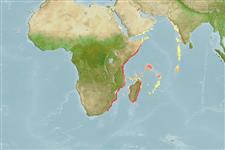Environment: milieu / climate zone / depth range / distribution range
Ecologia
marino; acqua dolce; salmastro demersale; catadromo (Ref. 51243). Tropical
Africa: Kenya to South Africa (Ref. 3506), uncommon south of the Save River (Ref. 7248, 52193). Also Reunion and Mauritius (Ref. 33390). Dominant eel species in the Zambezi system and farther north in East Africa (Ref. 52193).
Size / Peso / Age
Maturity: Lm ? range ? - ? cm
Max length : 175 cm TL maschio/sesso non determinato; (Ref. 48660); peso massimo pubblicato: 20.6 kg (Ref. 52193); Età massima riportata: 15 anni (Ref. 48660)
Spine dorsali (totale): 0; Spine anali 0.
Migratory species which breeds in the ocean (Ref. 52331), it requires rivers and oceans (Ref. 30558). Young fish migrate upstream with a continued feeding mode, especially on invertebrates found on rocks and logs washed by fast moving waters (Ref. 30558). They inhabit various niches in a river system (Ref. 13337) and penetrate far inland, surmounting formidable barriers in its upstream migration, including the Kariba and Cahora Bassa dams (Ref. 52193). Adults need moving water to migrate back to the ocean, especially after heavy rains (Ref. 30558). Their food consists of crabs, frogs and insects (Ref. 30558), and even fish, including trout in the streams of the eastern highlands of Zimbabwe (Ref. 2478, 52193). Caught with various types of nets.
Life cycle and mating behavior
Maturità | Riproduzione | Deposizione | Uova | Fecundity | Larve
Skelton, P.H., 1993. A complete guide to the freshwater fishes of southern Africa. Southern Book Publishers. 388 p. (Ref. 7248)
IUCN Red List Status (Ref. 130435)
Threat to humans
Harmless
Human uses
Pesca: commerciale; Pesce da pesca sportiva: si
Informazioni ulteriori
Nomi ComuniSinonimiMetabolismoPredatoriEcotossicologiaRiproduzioneMaturitàDeposizioneSpawning aggregationFecundityUovaEgg development
BibliografiaAcquacolturaProfilo di acquacolturaVarietàGeneticaElectrophoresesEreditarietàMalattieElaborazioneNutrientsMass conversion
Strumenti
Special reports
Download XML
Fonti Internet
Estimates based on models
Preferred temperature (Ref.
123201): 25 - 28.7, mean 27.1 °C (based on 306 cells).
Phylogenetic diversity index (Ref.
82804): PD
50 = 0.5000 [Uniqueness, from 0.5 = low to 2.0 = high].
Bayesian length-weight: a=0.00074 (0.00040 - 0.00138), b=3.18 (3.02 - 3.34), in cm total length, based on LWR estimates for this species & Genus-body shape (Ref.
93245).
Trophic level (Ref.
69278): 3.8 ±0.7 se; based on size and trophs of closest relatives
Resilienza (Ref.
120179): Basso, tempo minimo di raddoppiamento della popolazione 4.5 - 14 anni (tmax=15).
Fishing Vulnerability (Ref.
59153): Very high vulnerability (90 of 100).
